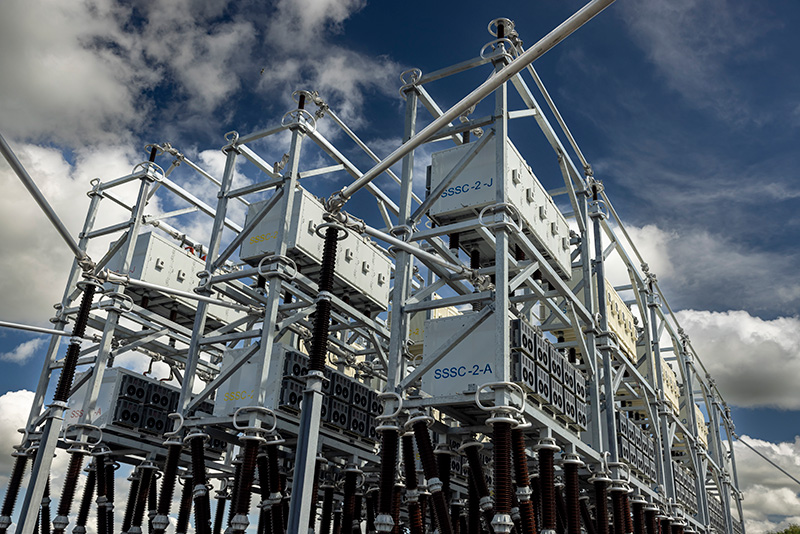
Technology in focus: APFC and TCSCs
May 12, 2025
There are many forms of power flow control solution for transmission and distribution grids, but the differences between these solutions are often not well understood. In this article, we compare two commonly known power flow control solutions—Advanced Power Flow Control (APFC) and Thyristor-Controlled Series Capacitors (TCSCs)—highlighting their similarities and differences.

What are APFC solutions and TCSCs?
Advanced Power Flow Control (APFC) refers to modular power electronics-based devices that belong to the FACTS (Flexible Alternating Current Transmission Systems) family. These solutions dynamically control power flows on transmission and distribution grids by changing the reactance of the line in real-time. APFC devices include SmartValve™, a modular, single-phase, voltage-agnostic Static Synchronous Series Compensator (m-SSSC) that can be easily scaled or relocated as network needs evolve. These devices enable utilities to efficiently manage congestion, enhance grid resilience, and optimize power transfer with precision. APFC technology is particularly valuable in modern power networks where adaptability and efficiency are crucial for managing dynamic load flows and grid variability.
Thyristor-Controlled Series Capacitors (TCSCs) are another type of FACTS device used for power flow control. They function by adjusting the effective series reactance of a transmission line using a thyristor-controlled reactor connected in parallel with a series capacitor. While TCSCs provide variable series compensation, they are mostly used to reduce line reactance. Although they can theoretically increase it in certain operating modes, this is rarely implemented in practice due to cost and complexity. TCSCs have historically been utilized to improve transient and voltage stability and damp power oscillations, making them an important solution for enhancing system reliability. However, their fixed design and site-specific nature tend to make them less versatile than APFC solutions in addressing evolving grid demands.
|
|
Advanced Power Flow Control |
Thyristor-Controlled Series Capacitors |
|
Deployment flexibility |
Modular, scalable solution that can be incrementally expanded or relocated based on network needs. |
Requires pre-determined installation in a fixed location, with limited ability for future expansion or relocation. |
|
Controllability |
Real-time, dynamic control via voltage source converter (VSC) technology with IGBTs, enabling fast and continuous adjustments. |
Controls power flow by switching thyristors to regulate series compensation. Response is fast but operates in discrete steps. |
|
Application |
Primarily used for power flow optimization, congestion management, and balancing line loading. |
Mainly used for transient stability improvement, damping oscillations, and enhancing system reliability. |
|
Response Speed |
Uses Pulse Width Modulation (PWM) switching of IGBTs such that the effective impedance can be continuously controlled. |
Uses phase-controlled thyristors that can only be turned on at specific points in the AC cycle. While fast, control is not continuous and may include operating restrictions near resonance conditions. |
|
Siting Considerations |
Flexible layout (e.g., double stacking) allows installation within existing substation spaces. |
Requires additional substation space for capacitor banks and thyristor control systems. In some cases, may require less space for high impedance compensation. |
|
Lead & Delivery Time |
12–18 months, including manufacturing, transportation, and installation. |
Typically, 2–4 years, due to engineering, procurement, and construction timelines. |
|
Redundancy & Reliability |
Modular system with built-in redundancy—failure of one module does not impact overall system performance. |
TCSCs often include redundancy in thyristors and cooling systems, though they do not provide the same fault isolation and flexibility as modular designs. |
While APFC and TCSC both offer power flow control capabilities, they have distinct differences. APFC provides greater flexibility, real-time controllability, and ease of deployment, making it particularly well-suited for modern power grid challenges. Unlike TCSC, which is primarily designed for stability improvements and capacitive controllability, APFC allows utilities to manage congestion, balance line loading, by the provision of capacitive and inductive controllability, and respond dynamically to real-time grid conditions.
APFC offers several key advantages, including:
- Scalability and adaptability – Modular design enables incremental expansion and redeployment as network needs change.
- Real-time dynamic control – Provides continuous power flow adjustments, improving grid efficiency and flexibility.
- Rapid deployment – Shorter lead times allow utilities to respond to urgent grid issues faster.
- Optimized grid operations – Enhances transmission efficiency, reduces congestion, and supports long-term grid planning.
With these benefits, APFC presents a compelling option for utilities looking to enhance grid reliability and efficiency. To learn more about power flow control solutions and how APFC can improve grid operations, contact us at info@smartwires.com.
Contributing expert
Hedd Roberts has been General Manager – Europe at Smart Wires since early 2022, working with customers across Europe to address their challenges with Smart Wires products and capabilities. Prior to that, he worked for National Grid in the UK in various senior roles covering regulation, customer connections, system development, investment management and the development of access and charging arrangements.
For press related purposes, please contact us at marketing@smartwires.com.
Dive deeper into related content
Explore our products and services
Talk to our experts



